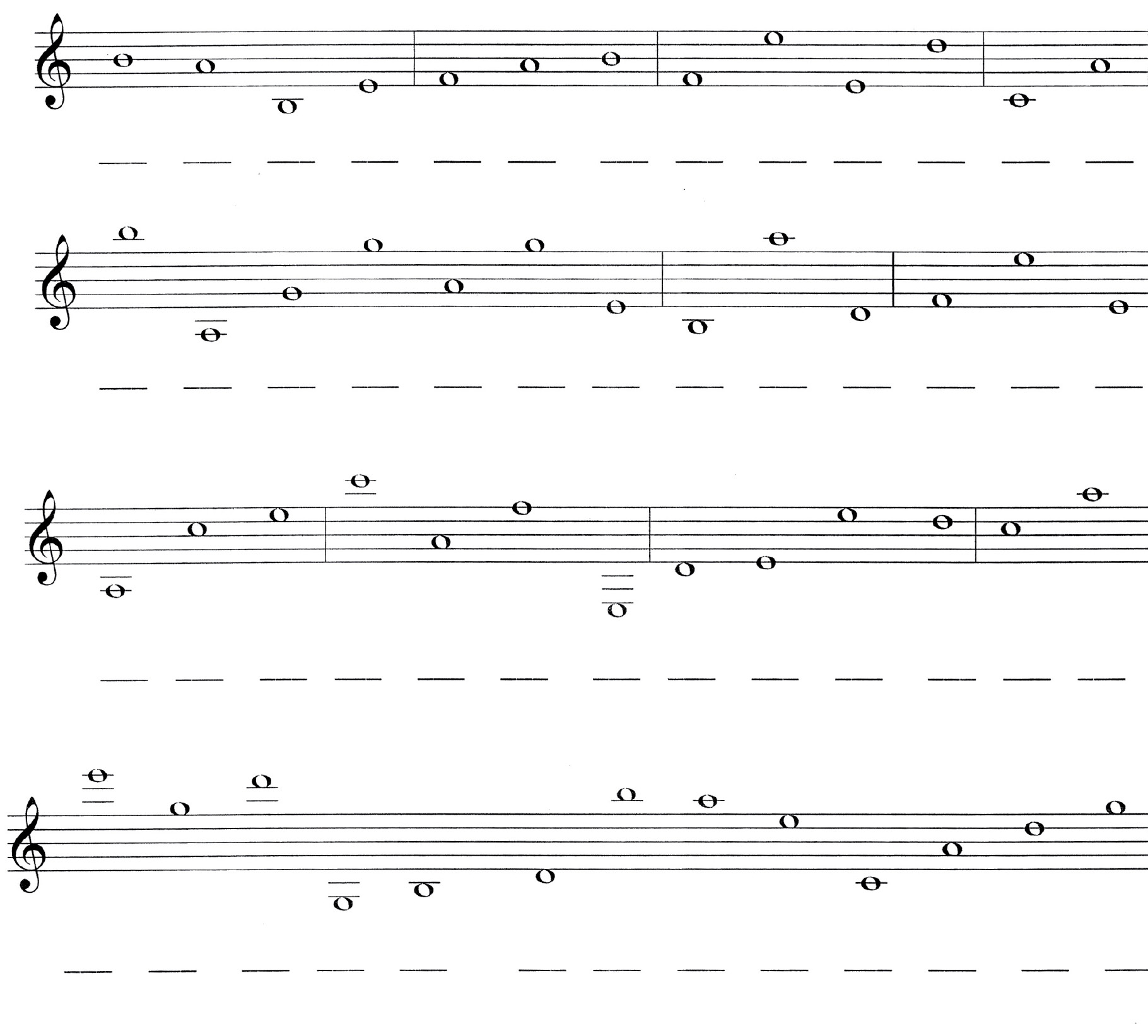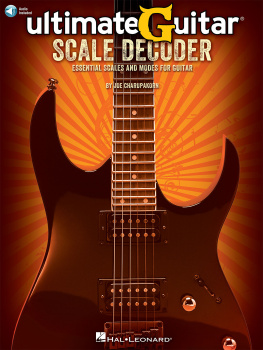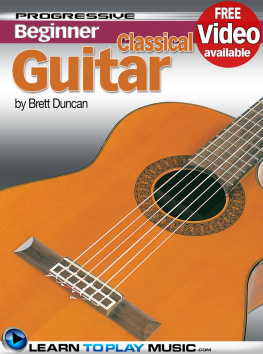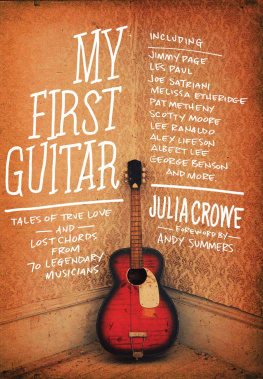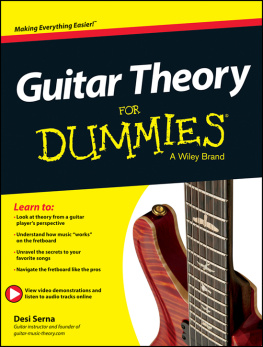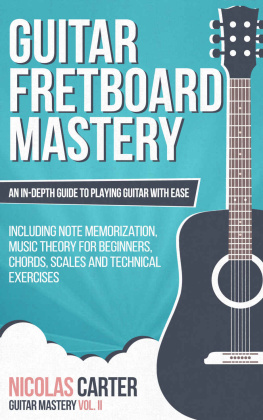Music Fundamentals for the Guitar
By Robert Bozina
The City College of San Francisco

Copyright 2012 by Robert Bozina. All rights reserved. No part of this publication may be reprinted, reproduced, transmitted, or utilized in any form or by any electronic, mechanical, or other means, now known or hereafter invented, including photocopying, microfilming, and recording, or in any information retrieval system without the written permission of University Readers, Inc.
First published in the United States of America in 2010 by Cognella, Inc.
Trademark Notice: Product or corporate names may be trademarks or registered trademarks, and are used only for identification and explanation without intent to infringe.
Printed in the United States of America
ISBN:

PREFACE
This text is for guitar players. As guitarists know, an essential strength of the instrument is its grounding in folkloric culture and oral traditions. Learning to read music, write music, and pursue the infinite body of knowledge that constitutes music theory are adjunct to the instrument itself yet these capacities are helpful to the preservation of repertory and advancement of skills.
ACKNOWLEDGMENTS
In the absence of Carmen, Carmela, and Trevor, this little work would have remained forever silent. And of course thanks to Lucy ( John Gilbert #77). Lucys voice tried and trued all.
Chapter One
BASIC ELEMENTS
Like language that is spoken and written, music uses a set of symbols to represent sounds. Musical sounds have four fundamental components: pitch , duration , intensity and tone . Intensity refers to the loudness of a sound. The extent to which composers control loudness will vary. Generally, the more technical skill one has developed on an instrument, the more one is able to control dynamic range (intensity). In broad terms, tone refers to the quality of a sound. If we play a note on the guitar and follow by playing the same note on a flute, the character of the sound (its tone) will be different. The word tone is also used to refer to the sophistication and opulence of sound one has developed on his/her instrument of choice. As a rule, guitarists are required to give a great deal of attention to tone development. Acquiring the sensitivity to sound and touch necessary takes many hours of practice. The notions of intensity (dynamic range) and tone are features that influence the expressive character of the music, are often highly individualized, and frequently distinguish one musician from another. On the other hand, the notions of pitch and duration are more absolute. Pitch designates height or depth of sound. As you move up the fret board (from left to right) pitch becomes higher. Duration refers to length of a sound. The organization of sound duration becomes rhythm. Pitch and duration tell us what sounds to make and how long to make them. To convey these features, we use staff notation.
PITCH
Pitch refers to the height or depth of a sound. On the guitar, as all string instruments, the thicker the string the lower its pitch. The thickest string on the guitar is the sixth string. The thinnest is the first. The sixth is lowest in pitch. The first is the highest in pitch. As we press the strings on the fret board and move up the neck (from left to right), the pitch becomes higher. As we move back down the neck the pitch becomes lower. Pressing the strings to the fret board is called fretting.
To name pitches, we use a series of letters called the musical alphabet . The musical alphabet consists of the first seven letters of our phonetic alphabet: ABCDEFG. These seven letters are repeated over and over as necessary. The pitch of any conventional musical sound is identified by using one of these seven letters. The system we use to notate pitch and other musical features is called staff notation . The musical staff consists of five horizontal, parallel lines and four spaces.

(ex. 1)
These five lines and four spaces constitute a staff (or stave). Any one of these lines or spaces may be referred to as a degree of the stave. In order for a stave to be complete, that is, in order for us to identify degrees of the stave with one of the seven letters of the musical alphabet, a clef sign is required. This is a symbol that is placed at the beginning of the stave. It fixes the letter name of one of the degrees of the stave and thereby fixes the letter name of all the degrees of the stave. There are several different clef signs and each one a ffects the stave differently. However, with very few exceptions, the guitar uses the treble clef sign exclusively. Another name for the treble clef sign is G clef . This is appropriate since the treble clef sign fixes the second line (from the bottom) of the stave as the note G. The treble clef sign is placed on the staff as shown.

(ex. 2)
As illustrated above, the second line up on the stave (the line nearly encircled by the bottom of the treble clef sign and marked with a note in parenthesis) is now fixed at G. Since the musical alphabet always runs sequentially (like the phonetic alphabet), all the degrees of the stave have therefore been named. The example below shows the names of all degrees of the treble staff.

(ex. 3)
Over time and with practice, the names of the degrees are memorized. In the beginning, it can be helpful to remember the spaces of the staff spell the word FACE.

If one thinks of all the pitches that are possible on the fret board, it is clear there are more possibilities than the eleven degrees of the staff allow. To accommodate all the notes that are above and below those indicated on these eleven lines and spaces, we use short, horizontal lines to extend the stave upward or downward. These short, horizontal lines used to extend the stave upward or downward are called ledger lines .

(ex. 5)
The notes in the above example represent notes on the open (unfretted) lowest string of the guitar through the first (highest) string at the twelfth fret. Notes requiring ledger lines are named. When drawing ledger lines, each note using ledger lines must have its own independent set of lines and no more ledger lines than necessary are used. The range (distance from the lowest note to the highest note) in example 5 is three octaves. An octave is the distance from one note to the nearest note (upward or downward) with the same letter name. The total range of the guitar is about three and one half octaves.
Exercises (1a)
Beneath each of the following notes, write its letter name:
